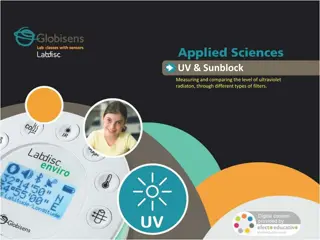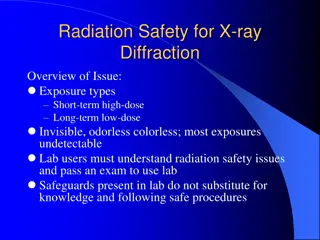Understanding UV Radiation and Sunblock Filters
This activity involves measuring and comparing ultraviolet radiation levels using different types of filters to study the effects of sunlight exposure on Earth. Learn about the positive and negative impacts of sun radiation, methods to prevent harmful effects, and the importance of skin products and eyewear protection. Explore the EM spectrum, UV rays, and their role in vitamin D production and photosynthesis, as well as the risks of eye and skin damage. Experiment with the SensorLab UV sensor to analyze the varying levels of UV radiation.
Download Presentation

Please find below an Image/Link to download the presentation.
The content on the website is provided AS IS for your information and personal use only. It may not be sold, licensed, or shared on other websites without obtaining consent from the author. Download presentation by click this link. If you encounter any issues during the download, it is possible that the publisher has removed the file from their server.
E N D
Presentation Transcript
UV & Sunblock Measuring and comparing the level of ultraviolet radiaton, through different types of filters.
UV & Sunblock Measuring and comparing the level of ultraviolet radiation, through different types of filters. Objective The purpose of this activity is to study the level of ultraviolet radiation resulting from the intervention of a sunlight beam through different types of filters, creating a hypothesis and proceeding to test it using the SensorLab UV sensor.
UV & Sunblock Measuring and comparing the level of ultraviolet radiation, through different types of filters. Introduction and theory The sun has always played a unique role in our environment, giving energy to living beings and directly warming up the planet. Human beings have always had to coexist with benefits and damages emerging from the presence of the sun. However, today we have more knowledge about the damaging effects of too much exposure to the sun.
UV & Sunblock Measuring and comparing the level of ultraviolet radiation, through different types of filters. Introduction and theory How could you physically define the sun radiation? Describe the positive and negative effects produced by the sun on Earth. Do you know methods to prevent negative effects from sun exposure? Carry out the experiment activity with your class so that at the end you ll be able to answer the following question: What is the precise role of skin products and eyewarethat protect against the sun?
UV & Sunblock Measuring and comparing the level of ultraviolet radiation, through different types of filters. Introduction and theory Theoretical The sun radiation is electromagnetic (EM) energy, which is transmitted through a vacuum. The EM radiation is made up of packets of energy or photons, which travel from the sun in a wave-like pattern. There is a scientific scale where the EM radiation is classified according to the wavelength, frequency and energy of the radiation: The EM spectrum. The UV radiation is a form of energy placed between the visible spectrum and X-rays. It is known that UV rays help the body to produce vitamin D3 and are also very important to create oxygen through photosynthesis. However prolonged exposure could cause eye and skin damage as a short-term consequence and skin cancer as a side effect.
UV & Sunblock Measuring and comparing the level of ultraviolet radiation, through different types of filters. Introduction and theory Sunlight brings three types of UV rays: UVA (longest wavelength), UVB and UVC (shortest wavelength). The UV radiation that touches us is made up of UVA and UVB rays, whereas UVC rays are absorbed by the ozone layer. Part of the UVB rays are also rejected by this layer. While the UVA reaches a deeper skin layer. UVB is the most harmful radiation to the eye. The sun protectors absorb and reflect the UV radiation range and other electromagnetic waves, acting as a filters. Sunglasses and sunscreens have chemicals that perform this function, thus Preventing direct passage of the UV energy to the eyes or skin.
UV & Sunblock Measuring and comparing the level of ultraviolet radiation, through different types of filters. Introduction and theory Now students are encouraged to raise a hypothesis which must be tested with an experiment. How effective are the classical methods to prevent sun damage? Are there differences between these types of sun filters?
UV & Sunblock Measuring and comparing the level of ultraviolet radiation, through different types of filters. Activity description Students will measure ultraviolet radiation from the sun, testing different types of sun filters, such as sunblocks (SPF 15 and 30)and sunglasses. They will evaluate these objects and substances according to the experimental results, using the SensorLab UV sensor.
UV & Sunblock Measuring and comparing the level of ultraviolet radiation, through different types of filters. Resources and materials SensorLab Enviro 1 plastic transparent film (10 x 6 cm) 1 cardboard (10 x 6 cm) Liquid silicone 2 pairs of sunglasses 2 sunblocks (FPS 15 and 30 preferably)
UV & Sunblock Measuring and comparing the level of ultraviolet radiation, through different types of filters. Using the SensorLab a. SensorLab configuration To collect measurements with the UV sensor, the SensorLab must be configured following these steps: Turn on the SensorLab pressing . Press and select SETUP by pressing . Now select the option SET SENSORS with , and choose UV . Then press . Once you have done that, you will be back at the setup, press one time and select SAMPLING RATE with . Now, choose MANUAL . To go back to the measurements press three times. Start measuring with and press every time you want to record a data. Once you are finished measuring stop the SensorLab by pressing (you will see the instruction Press SCROLL key to STOP ) and press .
UV & Sunblock Measuring and comparing the level of ultraviolet radiation, through different types of filters. Experiment First, make a sunblock testing-card cutting two windows out of the cardboard and pasting on to it the plastic film. Cover one window with one of the sunblocks and write the SPF in the cardboard surface. Repeat the procedure in next window and label it. Place the SensorLab in an open field and record the UV radiation pointing out the sensor directly to the sun.
UV & Sunblock Measuring and comparing the level of ultraviolet radiation, through different types of filters. Experiment Repeat the measurement, covering the sensor with each window of the sunblock testing card. Be sure the sunblock layer on the plastic is facing the sun. Measure the UV radiation through the sunglasses, covering the UV SensorLab sensor with two lenses from different sunglasses. Once you have finished, stop the SensorLab.
UV & Sunblock Measuring and comparing the level of ultraviolet radiation, through different types of filters. Results and analysis Connect the SensorLab to the computer using the USB communication cable or via the Bluetooth wireless communication channel. On the upper menu press and select . Choose the last experiment of the list. Select a bar graph results and label bars using the tool . from the GlobiLab menu to show the experiment
UV & Sunblock Measuring and comparing the level of ultraviolet radiation, through different types of filters. Results and analysis According to the experiment results, do the different solar protection methods work?. Which show better results? Did you find differences between both sunscreens and both sunglasses? How are the results related to your initial hypothesis?
UV & Sunblock Measuring and comparing the level of ultraviolet radiation, through different types of filters. Results and analysis The graph below should be similar to the ones the students came up with:
UV & Sunblock Measuring and comparing the level of ultraviolet radiation, through different types of filters. Conclusion Why can sunscreen and sunglasses prevent sun damage? Students should indicate based on the theoretical background that the composition of sunscreen and sunglasses includes chemical substances, which absorb and reflect UV radiation range and other electromagnetic waves, acting as a filters. Why did the sunblocks and sunglasses show different effectiveness? Students should infer that differential results were produced by the application of the cream over the plastic. Probably, sunblock is not as effective as on the skin, because the minimum percentage of protection known is around 90%.
UV & Sunblock Measuring and comparing the level of ultraviolet radiation, through different types of filters. Conclusion Why didn t the sunblocks show a correlation between SPF and UVI measured? Students should point out the sun protection factor indicates precisely the time of protection offered by the sunscreen. In other words if it takes 20 minutes for your unprotected skin to start turning red, using a SPF 15 prevents burning 15 times longer. However, both types of sunblocks are able to filter out similar percentages of UVB rays (i.e. SPF 15 = 93%; SPF 30 = 97%).
UV & Sunblock Measuring and comparing the level of ultraviolet radiation, through different types of filters. Activities for further application What do you think UV levels depend on? Research and answer the question. Students should mention some environmental factors related to this phenomenon. It is well known that the ozone layer is the classic guardian against radiation, especially UV. In addition, other factors such as time of the day and time of the year are related to the angle of the sun rays. We can also mention latitude and altitude. For Latitude, at the Equator the UC rays must travel the least distance through the atmosphere. For altitude, high altitude entails less atmosphere to absorb the radiation- and weather conditions. UV rays help us to produce vitamin D3, could you propose other benefits offered by UV radiation? Students could mention the opportunity to use UV radiation as a water purification method. For example, highly efficient mercury lamps transmit a broad range of the EM spectrum, including UV radiation. Pathogen organisms exposed to this then perish.























